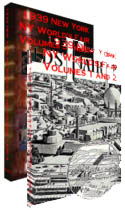The 1939 New York World's Fair
7 Zones of Excitement
The 1939 New York World's Fair was conceived during the depression with the idea of building something so fantastic that its very presence would lift the United States out of the doldrums of the depression. To accomplish this, the founders decided to make the 1939 worlds fair a truly international event by creating seven zones, each covering a different subject area.
The seven zones were: the Government Zone, the Community Interests Zone, the Food Zone, the Communications and Business Zone, the Production and Distribution Zone, the Transportation Zone and the Amusement Zone. The Government Zone was further broken up into three areas, the Country Zone, the Hall of Nations and the Court of States.
Each zone focused on a particular type of activity. Lets take a look at what each zone offered to people who attended the 1939 worlds fair.
The government zone was all about the various countries around the world and the states of the United States. The exhibit allowed people to explore the various cultural varieties that exist around the world in the various country exhibits and specialties of each state that was exhibiting at the fair. Additionally, there was a central Court of Peace which held a variety of events and was best known for its equestrian performances.
The Community Interest Zone of the 1939 New York World's Fair featured a variety of industries and trades that were of mass appeal - including art, gargens, the gas industries, textiles, home building materials and furniture, jewelry, cosmeticsm religion and many others. Its most striking feature was the Spiral Fountain which was located in the courtyard of Medicine & Public Health and the Science & Education building. It also featured the Town of Tomorrow, a collection of 15 state of the art homes. Each home was designed around a specific theme and each devoted a room that explained the materials that went into building that particular house.
The Food Zone was a showcase of industries and companies that helped prepare and make food available to the consumer. Companies that were featured included Borden, General Cigar, Heinz, Swift, Beech Nut and many others. And as its namesake suggested, you could purchase all sorts of food and drink here for consumption.
The Communications and Business Zone showcased a variety of companies and state of the art products - including AT&T, RCA, the U.S. Post Office, Crosley and many others. It also featured a communications building highlighting all the companies and products that were bringing us into the modern age of communications.
The Production and Distribution Zone of the 1939 Worlds Fair featured a large number of manufacturing companies and demonstrated how raw materials were used to produce finished products. Some of the companies represented include Con Edison, Dupont, Eastman Kodak, Elgin Watches, General Electric, US Steel and Westinghouse.
The Transportation Zone was all about transportation - including exhibits from Chrysler, Firestone, Ford, General Motors and many others. It also had exhibits about state of the art aviation, railroad and marine transportation. And it featured Futurama - a view of the United States in the 1960's.
And last but certainly not least was the Amusement Zone. The Amusement Zone was the most popular Zone in the park and it featured a variety of amusements, shows, rides and firework displays.
The 1939 New York World's Fair is much like the modern complex of Disney World and Epcot Center. Disney World (like the Amuzement Zone) is devoted to fun whereas Epcot Center (and the other 6 Zones) were devoted to both education and fun. What is most interesting is that the Amusement Zone was by far the most popular attraction. It seems that people at that time, weary of the depression, were looking for for escape than learning and in that aspect the 1939 worlds fair was a huge success.


